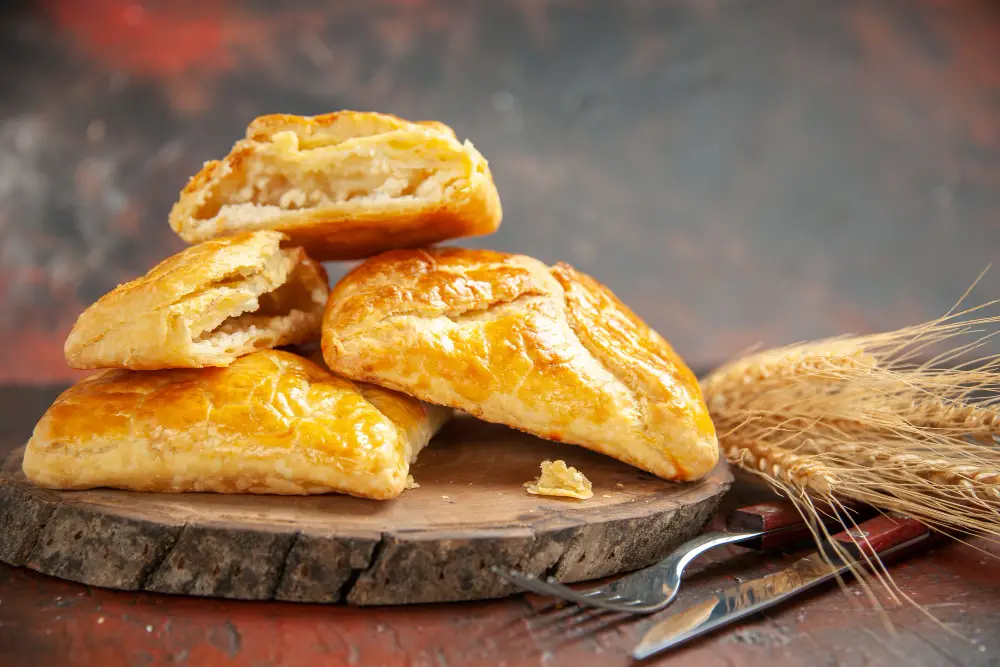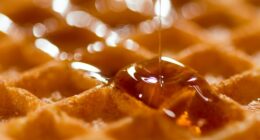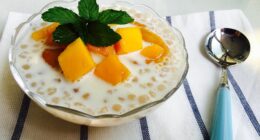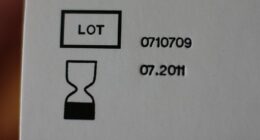Phyllo dough is paper-thin pastry, while puff pastry is layered and rises when baked due to butter layers.
TL;DR Phyllo Dough Vs. Puff Pastry
Phyllo dough is paper-thin sheets made from flour and water, resulting in a delicate and crisp texture when baked. It is commonly used in Greek cuisine to make popular dishes like spanakopita and baklava.
Puff pastry is made by layering butter between thin layers of dough. This creates a light and flaky texture that rises dramatically when baked. Puff pastry is often utilized in classic French pastries such as croissants and palmiers.
Phyllo Dough
Phyllo dough, also known as filo dough, is a paper-thin pastry that originated in the Mediterranean and Middle Eastern cuisines. It is made by rolling out unleavened dough into thin sheets and layering them with melted butter or oil.
Phyllo dough can be used in both sweet and savory recipes, making it a favorite among chefs worldwide. From classic baklava to spanakopita (a spinach and feta-filled pastry), the possibilities are endless when it comes to creating delectable treats with phyllo dough.
When baked, phyllo dough turns golden brown and becomes incredibly crispy, highlighting the layers within. Its light texture makes it ideal for dishes where you want the filling or ingredients inside to shine through without being overshadowed by a heavy crust.
Puff Pastry

Puff pastry is a flaky and buttery pastry made by repeatedly folding dough with layers of butter, resulting in a light and airy texture when baked.
Puff pastry, also known as pâte feuilletée, This flaky pastry can be used in both sweet and savory dishes, making it a staple in many culinary creations.
One of the key characteristics of puff pastry is its light and airy texture. When baked properly, the layers of butter within the dough create pockets of steam, causing the pastry to rise dramatically in the oven.
To achieve these delightful layers, puff pastry requires a process called lamination. Lamination involves folding layers of butter between layers of dough and then rolling them out repeatedly to create even more thin layers.
Phyllo Dough Vs. Puff Pastry – Key differences
| Aspect | Phyllo Dough | Puff Pastry |
|---|---|---|
| Texture | Paper-thin, delicate, crispy when baked | Flaky, buttery, rises into layers when baked |
| Ingredients | Flour, water, oil | Flour, water, butter |
| Preparation | Rolled very thin, sheets layered | Butter folded between layers of dough |
| Leavening Agent | None | Steam from butter layers during baking |
| Usage | Common in Mediterranean and Middle Eastern cuisines | Versatile, used in sweet and savory dishes |
| Dishes | Baklava, spanakopita, samosas | Croissants, turnovers, quiches |
| Versatility | Limited by thinness, may be challenging to work with | Versatile, suitable for various shapes and forms |
| Baking Technique | Baked at high heat, often brushed with butter between layers | Baked at moderate to high heat, rises into flaky layers |
| Examples | Greek baklava, Turkish borek | Puff pastry twists, Danish pastries |
| Thickness | Extremely thin | Moderately thin |
| Preparation Time | Requires careful handling and assembly | Requires multiple folds and chilling |
How to Make Phyllo Dough
Making phyllo dough from scratch can be quite challenging due to its thin and delicate nature. It requires skill and practice. Here’s a basic recipe for making phyllo dough:
Ingredients:
- 2 cups all-purpose flour
- 1/2 teaspoon salt
- 1/4 teaspoon vinegar or lemon juice
- About 3/4 cup warm water
- 1-2 tablespoons vegetable oil, for brushing
Instructions:
Mixing the Dough:
- In a large bowl, combine the flour and salt.
- Make a well in the center and add the vinegar or lemon juice.
- Gradually add warm water and mix with a fork or your hands until a shaggy dough forms.
Kneading:
- Transfer the dough to a floured surface and knead for about 10 minutes until it becomes smooth and elastic.
- Form the dough into a ball, coat it lightly with oil, and cover with plastic wrap. Let it rest for about 1 hour.
Dividing the Dough:
- After resting, divide the dough into small walnut-sized balls (about 1 inch in diameter).
Rolling Out the Dough:
- Take one dough ball and flatten it slightly.
- On a well-floured surface, roll out the dough ball as thin as possible using a rolling pin. You should be able to see your work surface through the dough.
Stretching the Dough:
- Gently stretch and thin the rolled-out dough by draping it over your knuckles and carefully stretching it outwards.
Assembling Layers:
- Brush each stretched layer with a thin layer of oil using a pastry brush.
Stack the oiled layers on top of each other.
Repeat:
- Continue rolling, stretching, and stacking the layers until you have the desired number of sheets. Traditionally, phyllo dough has around 10-15 layers.
Using Phyllo Dough:
- Phyllo dough can be used to make various dishes like baklava, spanakopita, and more. Follow your chosen recipe for further instructions.
Tips:
- Phyllo dough dries out quickly, so work efficiently and keep unused dough covered with a damp cloth.
- It’s common to have tears or imperfections in homemade phyllo dough, so don’t worry too much about perfection.
- If making phyllo dough from scratch seems daunting, you can also find pre-made phyllo dough in many grocery stores.
How to Make Puff Pastry
Making puff pastry from scratch can be a bit time-consuming, but the delicious, flaky results are definitely worth it.
Ingredients:
For the dough:
- 2 1/2 cups all-purpose flour
- 1 tsp salt
- 1 cup cold water
- 1 1/4 cups (2 1/2 sticks) unsalted butter, cold
For the butter block:
- 1 cup (2 sticks) unsalted butter, cold
Instructions:
Prepare the Dough:
- In a large bowl, mix the flour and salt together.
- Gradually add the cold water and mix until a dough forms. Be careful not to overmix; you want the dough to just come together.
- Shape the dough into a rough rectangle, wrap it in plastic wrap, and refrigerate for about 30 minutes.
Prepare the Butter Block:
- Place the cold butter between two sheets of parchment paper or plastic wrap.
- Use a rolling pin to gently pound and flatten the butter into a rectangle that’s about half the size of the dough.
Laminate the Dough:
- On a lightly floured surface, roll out the chilled dough into a larger rectangle, about twice the size of the butter block.
- Place the butter block in the center of the dough and fold the dough over the butter like an envelope, sealing the edges.
- Roll out the dough-butter packet into a larger rectangle again. This is your first fold.
Perform the “Turns”:
- Fold the top third of the dough down over the center, then fold the bottom third up over the top (like folding a letter). This is a single “fold.”
- Rotate the dough 90 degrees and roll it out again into a rectangle. This is your second fold.
- Repeat the folding and rolling process (2 more times for a total of 4 folds). This helps create the layers and flakiness in puff pastry.
Rest and Chill:
- After the final fold, wrap the dough in plastic wrap and refrigerate for at least 1 hour, or preferably overnight. This allows the gluten to relax and the butter to firm up.
Roll and Use:
- Once chilled, your puff pastry is ready to be rolled out and used for your desired pastry creation, such as croissants, turnovers, or a variety of other baked goods.
- Remember that working with puff pastry requires patience and attention to detail. Keep your work area and ingredients as cold as possible to ensure the butter doesn’t melt and compromise the flakiness of the layers.
Image Credits
Featured Image By – azerbaijan_stockers on Freepik
Image 1 By – KamranAydinov on Freepik









